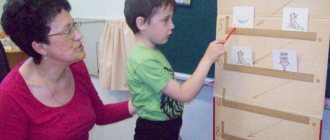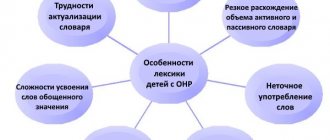The system of work on the formation of the phonetic side of speech includes several stages: 1) preparatory; 2) the stage of staging missing sounds; 3) the stage of automating the delivered sounds, introducing them into independent speech; 4) stage of differentiation of sounds.
Each of these stages differs in the content of speech therapy work. The preparatory stage includes a system of exercises aimed at developing the articulatory apparatus. The stage of staging missing sounds can be carried out in three ways: 1 by imitation, when the speech therapist explains and shows the articulation of a given sound;
2 mechanical method involves the use of probes and other devices that help the child reproduce a given articulatory pattern; 3 mixed method - simultaneous use of mechanical assistance and demonstration of correct articulation of sound. The stage of automating the given sounds provides for a system of speech exercises aimed at developing the ability to use the given sounds in independent statements. Lexical material should be varied and rich in the sounds being studied. In this case, defectively pronounced and mixed sounds are eliminated as much as possible. The stage of differentiation of sounds occurs after the pronunciation of all sounds that are similar in sound pronunciation or articulation has been well developed.
In the process of organizing remedial training, great importance is attached to general didactic principles. At the same time, for effective and lasting correction of pronunciation defects, it is necessary to take into account special principles:
— etiopathogenetic (i.e., taking into account the etiology and mechanism of speech production disorders);
— complexity of impact on all components of the speech system;
— a differentiated approach to the correction of various types of dyslalia.
Before carrying out correction work, it is necessary, according to the method, to examine the state of sound pronunciation:
1) examination of the structure and mobility of the articulatory apparatus;
2) examination of sound pronunciation;
3) examination of phonemic hearing.
1. When examining the articulatory apparatus, it is important to remember that the correct pronunciation of sounds is largely determined by the safety of each part of the peripheral speech apparatus: the oral and nasal cavities, as well as the pharynx and nasopharynx. When checking the structure of the tongue, teeth, lips, palate, jaws, it is necessary to determine whether their structure corresponds to the norm, and if not, what is the nature of the violation.
In the process of examining the mobility of the articulatory apparatus, the child is asked to perform a number of exercises by imitation:
- open and close your mouth;
- hold your tongue spread wide on your lower lip (2-3 seconds);
- lick the upper and lower lips with a wide tongue (by imitation, according to instructions);
- make circular movements with your tongue spread wide across the upper and lower lips;
- hold the tip of the tongue at the right and left corners of the mouth (2-3 seconds);
- click your tongue (3-5 times);
- click your tongue (“chase horses”);
- stretch your lips forward in a “tube”, and then stretch them into a smile (2-3 times);
— cause vibration of the lips by pronouncing the coachman’s “whoa”;
- puff out your cheeks;
- imitate the position of the “tube” with your tongue;
- perform 2-3 movements from those listed alternately.
When performing the above exercises, you need to pay attention to:
— clarity of articulatory movements;
- speed and smoothness of their playback;
- the ability to quickly switch from one articulatory structure to another.
2. When examining sound pronunciation, it is necessary to find out how the child pronounces the test sound in isolation, in words, syllables, sentences, texts, using appropriate didactic material.
3. When examining phonemic hearing, it becomes clear how children distinguish phonemes of their native language by ear. Techniques are used aimed at:
- recognition, discrimination and comparison of simple phrases;
- highlighting and memorizing given words in a series of similar sound compositions;
- distinguishing individual sounds in a sound series, in syllables, words;
- memorization and repetition of syllable series consisting of 2-4 elements.
The ability to perceive rhythmic structures of varying complexity, reproduce rhythmic patterns, etc. is studied.
Particular attention is paid to the distinction between whistling and hissing, hissing and affricates, and voiceless and voiced pairs of sounds.
Thus, sound pronunciation disorders in dyslalia
Analysis of all the data obtained will make it possible to determine the nature and cause of dyslalia and indicate the direction for correcting defects in sound pronunciation.[29]
Speech therapy intervention is a pedagogical process in which the tasks of corrective training and correctional education are realized.[16]
The main goal of speech therapy for dyslalia is the formation of skills and abilities to correctly reproduce speech sounds. To correctly reproduce speech sounds (phonemes), a child must be able to: recognize speech sounds and not confuse them in perception (i.e., distinguish one sound from another based on acoustic characteristics); distinguish normalized sound pronunciation from non-standardized ones; exercise auditory control over one’s own pronunciation and evaluate the quality of sounds reproduced in one’s own speech; take the necessary articulatory positions to ensure a normalized acoustic effect of sound; vary the articulatory patterns of sounds depending on their compatibility with other sounds in the stream of speech; accurately use sound in all types of speech.
The speech therapist must find the most economical and effective way to teach the child pronunciation.
With proper organization of speech therapy work, a positive effect is achieved for all types of dyslalia. With mechanical dyslalia, in some cases, success is achieved as a result of joint speech therapy and medical intervention.
A prerequisite for success with speech therapy is the creation of favorable conditions for overcoming pronunciation deficiencies: emotional contact between the speech therapist and the child; an interesting form of organizing classes, corresponding to the leading activity, stimulating the child’s cognitive activity; combinations of work methods to avoid fatigue.
Speech therapy intervention is carried out in stages, while at each stage a specific pedagogical task is solved, subordinate to the general goal of speech therapy intervention.
Stages of speech therapy intervention
1. Preparatory stage. Its main goal is to include the child in a targeted speech therapy process. To do this, it is necessary to solve a number of general pedagogical and special speech therapy problems.
One of the important general pedagogical tasks is the formation of an attitude towards classes: the speech therapist must establish a trusting relationship with the child, win him over, adapt him to the environment of the speech therapy room, arouse his interest in classes and the desire to get involved in them. Children often experience stiffness, shyness, isolation, and sometimes fear of meeting unfamiliar peers and adults. The speech therapist is required to be especially tactful and friendly; Communication with the child should be carried out without formality and excessive severity.[14]
An important task is the formation of derivative forms of activity and a conscious attitude towards classes. The child must learn the rules of behavior in class, learn to follow the instructions of the speech therapist, and actively participate in communication.
The tasks of the preparatory stage include the development of voluntary attention, memory, mental operations, especially analytical operations, comparison and inference operations.
Special speech therapy tasks include: the ability to recognize (recognize) and distinguish between phonemes and the formation of articulatory (speech motor) skills.
Depending on the form of dyslalia, these tasks can be solved in parallel or sequentially. With articulatory forms (phonemic and phonetic), in cases where there are no disturbances in perception, they are solved in parallel. The formation of receptive skills can be reduced to the development of conscious sound analysis and control over one’s own pronunciation. With the acoustic-phonemic form of dyslalia, the main task is to teach children to distinguish and recognize phonemes based on intact functions. Without solving this problem, you cannot move on to forming the correct pronunciation of sounds. For work on the correct pronunciation of a sound to be successful, the child must be able to hear it, since the regulator of normal use is hearing.
In mixed and combined forms of dyslalia, work on the development of receptive skills precedes the formation of the articulatory base. But in case of gross violations of phonemic perception, it is also carried out in the process of forming articulatory skills.
Work on the formation of the perception of speech sounds is based on the nature of the defect. In some cases, work is aimed at the formation of phonemic perception and the development of auditory control. In others, its task includes the development of phonemic perception and sound analysis operations. Thirdly, it is limited to the formation of auditory control as a conscious action.
In this case, the following provisions must be taken into account.
• The ability to recognize and distinguish speech sounds as conscious. This requires the child to restructure his attitude towards his own speech, directing his attention to the external, sound side, which he was not previously aware of. The child needs to be specially trained in the operations of conscious sound analysis, without relying on the fact that he spontaneously masters it.
• The initial units of speech must be words, since sounds - phonemes exist only as part of a word, from which they are isolated during analysis through a special operation. Only then can they be operated as independent units and observed as part of syllable chains and in isolated pronunciation.
• Operations of sound analysis, on the basis of which the skills and abilities of conscious recognition and differentiation of phonemes are formed, are carried out at the beginning of work on material with sounds correctly pronounced by the child. After the child learns to recognize a particular sound in a word, determine its place among other sounds, and distinguish one from another, you can move on to other types of operations, relying on the skills developed in the process of working on correctly pronounced sounds.
• Work on developing the perception of incorrectly pronounced sounds must be carried out in such a way that the child’s own incorrect pronunciation does not interfere with him. To do this, at the time of performing sound analysis operations, the child needs to limit or eliminate his own pronunciation as much as possible, transferring the entire load to the auditory perception of the material.
• It is advisable to include the child’s pronunciation in subsequent lessons, when there is a need to compare his own pronunciation with the standardized one.
With phonemic dyslalia, it is necessary to form the missing movements of the organs of articulation; make a correction to an incorrectly formed movement. In cases where the sound is distorted due to disturbances in the method or place of its formation, a combination of both techniques is necessary.
To form an articulatory base, types of exercises, didactic requirements and methodological recommendations, and guides for correcting pronunciation have been developed.
With dyslalia there are no gross motor disorders. A child with dyslalia has not developed some speech-specific voluntary movements of the organs of articulation. The process of forming articulatory movements is carried out as voluntary and conscious: the child learns to produce them and control the correct execution. The necessary movements are first formed by visual imitation: the speech therapist in front of the mirror shows the child the correct articulation of sound, explains what movements should be made, and invites him to repeat. As a result of several tests, accompanied by visual control, the child achieves the desired position. If there are difficulties, the speech therapist helps the child with a spatula or probe. In subsequent lessons, you can be asked to perform the movement according to verbal instructions without relying on a visual model. The child subsequently checks the correctness of execution based on kinesthetic sensations. Articulation is considered mastered if it is performed accurately and does not require visual control.
When working on developing correct pronunciation, it is necessary to avoid mentioning the sound that is being worked on.
As the child completes the task, the speech therapist checks whether he has chosen the correct position for pronouncing the desired sound. To do this, he asks the child to exhale (“blow strongly”) without changing his position. When you exhale forcefully, an intense noise occurs. If the noise corresponds to the acoustic effect of the desired voiceless consonant, then the pose is taken correctly. If not, then the speech therapist asks the child to slightly change the position of the articulation organs (raise, lower, move the tongue a little) and blow again. The search for the most successful position is carried out until a positive result is obtained.
In some cases, listening to the noise produced, the child identifies it with a normalized sound and even tries to independently incorporate it into speech. Since this does not always lead to positive results, the speech therapist should in such cases divert attention from the sound by switching to another object.
With dyslalia, there is no need for an abundance of exercises for the organs of articulation; those that will result in the formation of the necessary movements are sufficient. Work is being carried out on individual speech movements that have not been formed in the child during the process of speech development.
Requirements that must be made for articulation exercises:
1. Develop the ability to take the required pose, hold it, smoothly switch from one articulatory pose to
another.
2. The system of exercises for the development of articulatory motor skills should include both static exercises and exercises aimed at developing dynamic coordination of speech movements.
3. Exercises are needed to combine movements of the tongue and lips, since when pronouncing sounds, these organs are involved in joint actions, mutually adapting to each other (this phenomenon is called).
4. Classes should be conducted briefly, but repeatedly, so that the child does not get tired. During pauses, you can switch it to another type of work.
5. Pay attention to the formation of kinesthetic sensations, kinesthetic analysis and ideas.
6. As the speech therapist masters the movements necessary to realize the sound, he moves on to practicing the movements required for other sounds...
2. We set the goal for the formation of primary pronunciation skills:
The goal of this stage is for the child to develop the initial skills of correctly pronouncing sounds using specially selected speech material. Specific tasks are: production of sounds, development of skills for their correct use in speech (automation of skills), as well as the ability to select sounds without mixing them with each other (differentiate).
The need to solve these problems in the process of speech therapy work follows from the laws of ontogenetic mastery of the pronunciation aspect of speech.
Sound production is achieved using technical techniques described in detail in specialized literature. In the works of F.F. There are three methods of Pay: by imitation (imitative), with mechanical assistance and mixed.
When setting a sound as its initial basis, one should turn not to an isolated preserved sound, but to a sound in a syllabic combination, since a syllable is a natural form of sound implementation in speech... This provision is very important due to the fact that when setting With an isolated sound, the transition to a syllable is often difficult. It is necessary to provide for possible dynamic changes in the articulation of the same phoneme in different sound environments. This is achieved without much difficulty, since the patterns (programs) of sound combinations in a child with dyslalia are not disrupted.
As the sound turns out to be placed in one of the syllable positions, work is underway to include it in speech, or automate it.
The process of sound automation consists of training exercises with specially selected words that are simple in phonetic composition and do not contain broken sounds.
It often turns out that already in the process of automation, the child begins to freely include the delivered sound in spontaneous speech. If he does not mix it with others, then there is no need for subsequent work on them. In speech therapy practice, there are cases when further continuation of work on sound is required, in particular on its differentiation from other sounds, i.e. differentiation.
Work on the differentiation of sounds helps to normalize the operation of their selection.
When working on the differentiation of sounds, no more than a pair of sounds are connected at the same time; if a large number of sounds of one articulatory group are needed for work, they are still combined in pairs.
3. Stage of formation of communication skills. Its goal is to develop in the child the ability to accurately use speech sounds in all communication situations.
In classes, texts are widely used, rather than individual words, various forms and types of speech are used, creative exercises are used, and material rich in certain sounds is selected. This kind of material is more suitable for classes on sound automation. But if at this stage the child works only on specially selected material, then he will not master the selection operation, since the frequency of this sound in special texts exceeds their normal distribution in natural speech. And the child must learn to operate with them.
Cases of complex or combined functional and mechanical dyslalia require clear planning of lessons, reasonable dosage of material, determination of the sequence in correcting sounds, as well as an idea of which sounds can be included in the work simultaneously, and which should be worked out sequentially.
Thus, the content of speech therapy work to eliminate dyslalia in preschool children is:
· the pedagogical process in which the tasks of corrective teaching and correctional education are realized.
· the main goal of speech therapy for dyslalia is the formation of skills and abilities to correctly reproduce speech sounds.
· carry out auditory control over one’s own pronunciation and evaluate the quality of sounds reproduced in one’s own speech;
· take the necessary articulatory positions to ensure a normalized acoustic effect of sound; vary the articulatory patterns of sounds depending on their compatibility with other sounds in the stream of speech;
· accurately use sound in all types of speech.
Thus, based on the study of theoretical sources, the following conclusions can be drawn:
Corrective work will be based on the form of the disorder and determination of the structure of the speech defect.
It should be noted that not in all cases of pathological deviations in the structure of the articulatory apparatus there is a violation of sound pronunciation. The compensatory capabilities of each child and adult are different, therefore, in the presence of certain defects of the articulatory organs, in some cases, correct reproduction of sounds is observed.
Features of the organization of correctional and speech therapy work at school
The organization of speech therapy and correctional programs in special schools and regular educational institutions has its own specific features:
- The work is organized differentially, i.e. Based on the diagnosis of a specific speech disorder, the child is sent to the school of the type that is most suitable for him. In each school, priority areas of work are selected based on the specifics of speech development disorders. In addition, in general educational institutions, special training programs are used for children with speech disorders. In some cases, they are assigned separate classes. It all depends on the degree of manifestation of the speech defect.
- Conducting a comprehensive diagnosis of children’s speech development based on drawing up speech cards and determining directions for correctional work.
- Corrective work is carefully planned and forecasts of its outcome are made.
- Taking into account the characteristics of various speech deviations, the degree of their severity, and the presence of minor deviations affects the methods and techniques of speech therapy correction in a school of one type or another.
- Creating conditions for normal learning and development of children with speech disorders in secondary schools.
- Taking into account the needs and developmental characteristics of students with hearing impairments, vision impairments and musculoskeletal problems.
- The basis of correctional work is the principle of accessibility and consistency of training, its comprehensive organization. Corrective therapy should create conditions so that learning is accessible to the perception of a child with specific speech defects, and goes from simple to complex using a variety of techniques and methods.
- The importance of carrying out preventive measures to prevent the development of speech defects and related deviations.
- Correctional work in primary school has immediate and promising results. It creates conditions for the formation of key competencies of students, adapting them to social life and building communicative connections, regardless of the presence of a speech defect.
- The use of modern ICT technologies in correctional classes. They contribute to the activation of thinking, develop the mental processes necessary for full speech development and mastery of the educational program.
Are you an expert in this subject area? We invite you to become the author of the Directory Working Conditions





